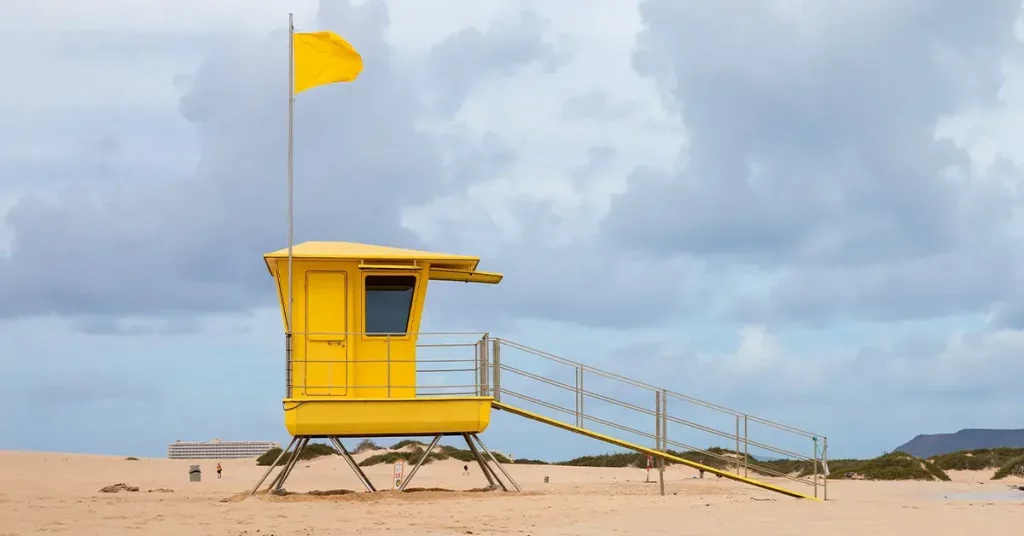When you head to the beach for a fun trip, the last thing you’re thinking of is “What do the flags mean at the beach?” Let’s take a look at understanding what the colored warning flags mean so you can stay safe on your vacation.
In case of the absence of knowledge, the many warning signs and beach flag can confuse beach goers. If you ask the coastal communities, they’ll tell you all about the dangerous marine life. It’s not merely enough to go with a life vest and a first-aid kit: It’s important to learn about the public safety rules, rip currents, interpretive signs, and the warning system at the beaches.
Why We Need Colored Beach Flags

When you arrive at a beach, and have set up your family base camp, coolers and tents, one of the first things you’ll notice is the array of beach warning flags. But what do they mean?
The beach flags remind beach goers to exercise caution and if someone fails to follow those they venture out at their own risk.The United States Lifesaving Association joined hands with the International Lifesaving Federation to develop a uniform flag warning system. Most coastal communities across the world have adopted this system and use an array of warning flags.
There are potential hazards on the water but the beach safety flags are an effective way of safeguarding the lives of beach visitors. Every purple flag, green flag, yellow flag, red flag, and double red flag is there to indicate a different kind of danger in the sea. There are also flags used to specifically discern between surfing and swim areas. But for this article, we’ll talk about the colored beach flags and what they mean in regards to safety.
What Do Colored Beach Flags Mean?

Surf and tide conditions vary per region. While there are endless public beaches to enjoy in various parts of the state, it is also important to be aware of conditions prevailing in your choice of beach location. For instance, you may sit there, admiring the yellow flags as a colorful symbol but you may not know that they’re warning flags for a purpose after all.
Those who are not too well-informed about the dangerous marine life and are merely occasional visitors may fail to recognize the dangers they face. They may simply be heading out for a harmless day of family fun but they may not know about things like high hazards, moderate surf conditions, or extremely high hazards.
Therefore, the governments make funds available to install free warning flags in all the public beach access areas. It also provides interpretive signs so that everyone can have an idea of the meaning of beach warning flags.
Uniform Warning Flag System and Flag Colors Explained

The International Lifesaving Federation adopted the different colors of the warning flags as part of their beach warning flag program. You will also note the difference in symbols, sizes, and flag colors that assist in improving the efforts for public safety. Coastal communities undertake the responsibility of installing the beach warning flags, ensuring their proper use, and maintaining them.
Here is a list of what the colored beach flags mean at the
Yellow Flag
A yellow flag means that the sea conditions are rough but not really life-threatening.
During the high surf season, you will mostly see a yellow flag lining every part of your favorite beach. A yellow flag is typically indicative of undertows, dangerous currents, high surf conditions, and such. If you spot a yellow flag when you’re at the beach, it is best to only swim near the lifeguards. If you’re not a very skilled or experienced swimmer, then it is best to venture into the waters with a life jacket.
Double Red Flag
The double red flag means “extreme caution” and signifies that the beach is closed to public use.
Red Flag
The red flag means that the surf is dangerously high and there are very strong currents.
A red flag is perhaps the most serious of all. You must exercise extreme caution when you see a red flag on the beach. I recommend staying away from the waters in such conditions but if there is an abs0lute need, then only venture into the rough sea if you’re a very strong swimmer. if you see double red flags, you need to be on high alert. Double red flags mean that beach is closed for swimming for even the strongest of swimmers.
Purple Flag
The purple flag is indicative of the presence of jellyfish, sharks, and other dangerous sea creatures.
Even dark blue flags indicate that there are potentially harmful sea animals nearby or that have been spotted. If the waters are not closed for swimming, then at least exercise caution.
Green Flag
A green flag indicates that the waters are completely safe for swimming.
While the sea is always unpredictable and one must always be careful even on clear calm days, green flags mean you can enjoy a fearless day on the beach.
How to Identify Rip Tides

Rip tides can be life-threatening. they’re the type of current that carry tidal waves underneath the surface of the water. As beach swimmers, everyone must know how to identify fast-moving water or powerful rip currents.
These are currents flowing away from the beach and here’s how to recognize them:
- Seeing discolored water or seaweed pulling away from the shore
- Noting foam on the beach
- The waves don’t appear to be breaking
In case a rip current does trap you, start swimming parallel to the shore rather than swimming in a straight line.
Swimming Safety Tips for the Beach

It’s good to brush up on the safety tips that the United States Lifesaving Association has compiled for beach swimmers:
- Become a skilled swimmer before venturing into the sea.
- Stay close to lifeguards when swimming as a beginner.
- Do not ignore the warning flags and signs on the beach.
- Enroll in rip current safety courses for better protection.
- Wade into the water with your feet first.
- Take a chaperone along if you’re venturing into the sea waters as a beginner.
- Do not ignore the importance of life jackets.
- Consult the lifeguards before wading into the waves.
Exercising Caution at the Beach

One cannot doubt that the beach is a great place to have fun but you must never lose sight of safety guidelines and rules. There are many hazards present but that does not mean you must deprive yourself and your family of an excellent summer retreat. The only thing to ensure is to maximize safety for everyone by following all safety rules and protocols on your outing.
These beach safety rules include:
- Do not take your eyes off the little ones at all. Make sure there is an adult supervising the kids throughout your time at the beach. The adults could all take turns watching the kids.
- If you intend to go boating or swimming, you must avoid consuming alcohol.
- Do not be careless in following all posted beach safety regulations and rules.
Final Thoughts
The beach is the topmost favorite destination for families around the world, especially during the summer months. The refreshing waters of the sea, the glorious sandy stretches and the plethora of water activities to enjoy draw visitors of all ages. However, there are plenty of dangers surrounding the sea, from high surf conditions, tidal waves, rip currents, and even life-threatening sea creatures.
Before one wades into the ocean, it is important to learn all about the safety rules and regulations. In fact, it is also extremely important to educate every member of your family about the warning signs, the warning beach flags, and the interpretive signs that beach authorities install.
The United States Lifesaving Association has developed a uniform warning flag system, along with interpretive signs to remind the public to exercise caution. Ignorance of those could expose everyone to the various life-threatening conditions at the sea. While many love the adventure of swimming in big waves, it is never worth the risk if you do not take all necessary cautions to protect your life first.




